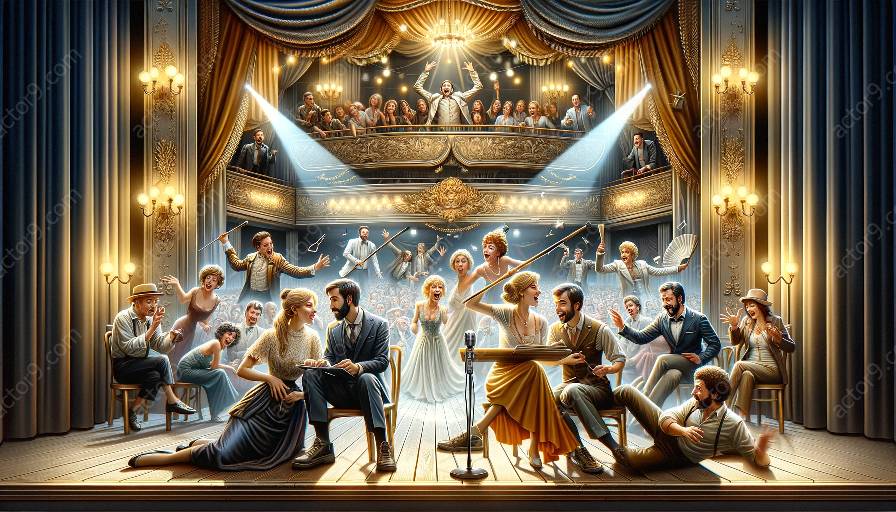Improvisation and comedy are two intertwined concepts in the performing arts world, each contributing to the overall art form in its own unique way. In this comprehensive topic cluster, we will explore the relationship between improvisation and comedy in theatre and performing arts, including their history, techniques, and impact.
History of Improvisation and Comedy
Both improvisation and comedy have deep roots in various cultures throughout history. Improvisation, the spontaneous creation of dialogue, scenes, and characters, has been used as a theatrical technique for centuries, dating back to ancient Greece and the Roman Empire. On the other hand, comedy, the art of causing amusement and laughter, has been an integral part of human expression since the earliest recorded performance traditions.
These two art forms often intersected, with improvisation being a key element of comedic performances in ancient rituals, street theatre, and early forms of drama. As theatre evolved over time, improvisation and comedy continued to influence each other, resulting in the development of comedic improvisation as a distinct genre within the performing arts.
Exploring Improvisation in Theatre
Improvisation in theatre is a spontaneous form of performance that emphasizes creativity, collaboration, and quick thinking. Actors engage in unscripted interactions, often relying on their instincts and imagination to create compelling moments on stage. The art of improvisation allows performers to explore characters and situations in real-time, adding an element of unpredictability and freshness to the theatrical experience.
Improvisational theatre encourages actors to work collectively, building narratives and relationships on the spot. This process can result in a rich, organic storytelling that captivates audiences and keeps them engaged throughout the performance. Many theatre companies and troupes specialize in improvisation, showcasing the art form through a variety of formats, including short-form games, long-form storytelling, and audience-inspired scenes.
The Techniques of Comic Improvisation
Within the realm of comedic improvisation, performers employ a range of techniques to elicit laughter and entertainment. These techniques include:
- Quick Wit: The ability to think and respond rapidly, often resulting in humorous exchanges and banter.
- Physical Comedy: The use of exaggerated movements and gestures to convey humor and comedic timing.
- Character Creation: Developing and embodying distinct characters with comedic traits and quirks.
- Wordplay and Puns: Crafting clever wordplay and puns to generate laughter and amusement.
These techniques allow performers to generate spontaneous comedy, improvising jokes, and comedic scenarios that cater to the energy of the moment and the audience's response.
The Intersection of Improvisation and Comedy
When it comes to the relationship between improvisation and comedy, the two concepts are deeply intertwined. Improvisation serves as a fertile ground for comedic exploration, providing performers with the freedom to experiment with humor in real-time. The unscripted nature of improvisation allows for the discovery of unexpected comedic moments, enabling actors to react and adapt to comedic opportunities as they arise.
Conversely, comedy enhances the practice of improvisation by infusing performances with levity and entertainment. Humor can serve as a powerful tool in engaging audiences and creating memorable experiences during improvisational theatre productions. Whether through clever wordplay, physical humor, or absurd situations, comedy injects a sense of lightheartedness and joy into the world of improvisational performance.
The Impact of Improvisation and Comedy
Both improvisation and comedy have had a significant impact on the landscape of theatre and performing arts. Improvisation encourages spontaneity and creativity, fostering a dynamic exchange between performers and audiences. It has also contributed to the evolution of theatrical styles and techniques, influencing the way stories are told and characters are portrayed on stage.
On the other hand, comedy has the power to unite people through laughter, offering a shared experience that transcends cultural and linguistic barriers. When combined with improvisation, comedy becomes a catalyst for engaging, interactive performances that resonate with diverse audiences. The impact of comedic improvisation extends beyond the stage, bringing joy and entertainment to communities around the world.
Conclusion
In conclusion, the relationship between improvisation and comedy in theatre and performing arts is a dynamic and multifaceted one. From their historical origins to their contemporary impact, improvisation and comedy continue to enrich the performing arts landscape, captivating audiences and inspiring performers to embrace spontaneity, creativity, and humor. By exploring the interplay between improvisation and comedy, we gain a deeper understanding of the art of theatrical improvisation and its inherent connection to the universal language of laughter.




























